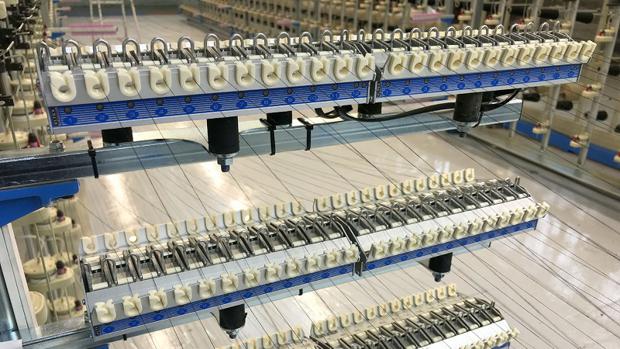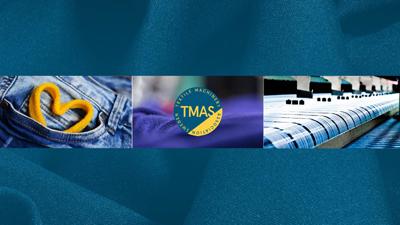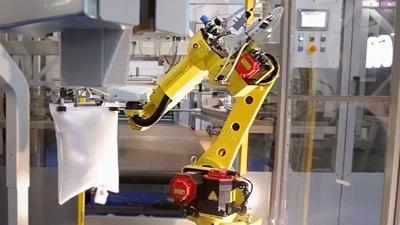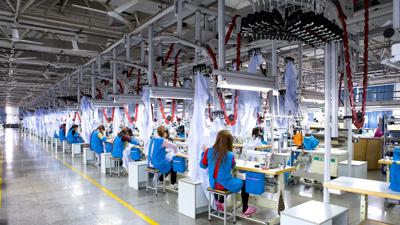TMAS @ ITMA 2023

(Source: TMAS/Eltex)
There is a strong case for considering the weaving process as the digital forerunner over 200 years ago. The first jacquard loom was controlled by perforated cards and the first automated machine for which elaborate patterns were stored on them in ones and zeros, arguably setting the ball rolling for binary computer programming and all that has followed.
The Swedish Textile Machinery Association (TMAS), Stockholm/Sweden, will be introducing significant new automation concepts for weaving at the ITMA in Milan/Italy from June 8-14, 2023.
Vandewiele Sweden
TMAS member Vandewiele Sweden AB, Ulricehamn/Sweden, as part of the Vandewiele Group, Brussels/Belgium, benefits from all of the synergies and accumulated know-how of one of the market leaders in comprehensive weaving technologies. At the ITMA, Vandewiele Sweden will present its latest X4 yarn feeders with integrated accessory displays with which current settings and any alarms can be easily monitored and any required changes seamlessly carried out.
X4 feeders are available in 3 different versions – with an integrated tension display (TED), with integrated active tension control (ATC), or with quick release, which enables weft tension settings to be transferred from one machine to another, enabling a fast start-up the next time the same article is woven. The position of the S-Flex Tensioner is constantly monitored by an internal sensor – even if adjustment is made during power off.
With the ATC-W active tension control, the required tension is easily set and monitored on the integrated display. Once set, the system constantly regulates itself, ensuring consistent yarn tension during the weaving process which is constantly and accurately measured by the ATC sensor unit, sending a signal to the ATC operator unit resulting in consistently stable yarn tension at the required level. Quick release meanwhile provides a quick and easy way to change the brushring or tensioner.
At the ITMA 2023, Vandewiele Sweden is also launching its own e-commerce platform for ordering the market’s leading range of textile accessories.
Texo
Texo AB, Älmhult/Sweden, has seen a surge in the demand for its Compfelt weaving looms for press felt base fabrics. Conventional weaving machines generally range in their working widths from 1.9 m to 3.2 m, with those purpose-built for technical applications such as geotextiles extending to wider widths of 6 m and beyond. Meanwhile, one of the machines the company recently delivered and commissioned has a 23 m working width.
The demand for such machines comes from the suppliers of paper machine clothing (PMC) to paper mills, who in turn operate colossal machines for paper manufacturing. All paper machines require a regular supply of PMC fabrics which are employed in 3 separate areas of the paper machine – the forming section, the press section and the drying section.
The PMC can have a significant impact on the quality of the paper, the efficiency of a machine and machine production rates. Texo Compfelt weaving machines are specifically employed for the production of endless (tubular) woven base fabrics for the press section of paper machines, where water is mechanically removed from the newly formed sheet of fibers.
Eltex of Sweden
Live demonstrations of the latest version of EyETM, a versatile multi yarn tension monitoring system, will be run by Eltex of Sweden AB, Osby/Sweden, at the ITMA.
The Eltex EyETM system is being widely adopted by weavers but unlike weft break sensors that are fitted solely on the weft insertion systems of weaving machines, it monitors the warping process prior to weaving. This means that instead of monitoring only the 6 to 8 weft yarns fed by the weft insertion system, the EyETM system is monitoring literally hundreds of yarns in real time on a warping creel.
With warping that can operate at speeds of 500 m/min, the yarn tension values from all yarns are continuously updated and displayed on a screen with pre-set warning levels indicated in red. When tension reaches outside the pre-set stop level, the machine is immediately halted, with indications both on the sensor’s LEDs as well as on the screen.



